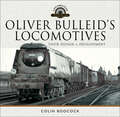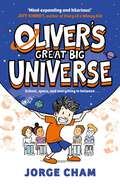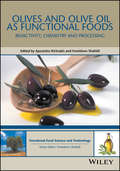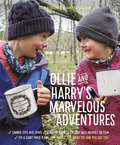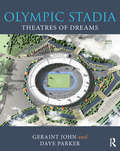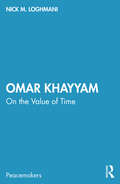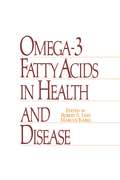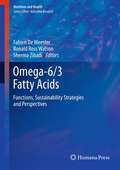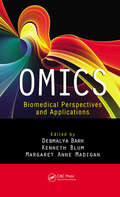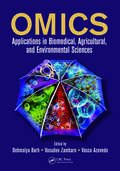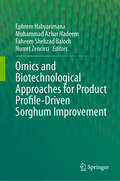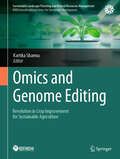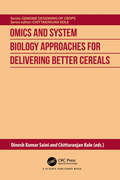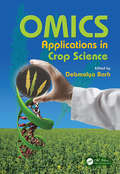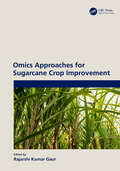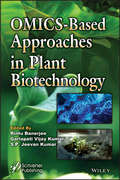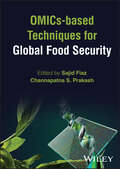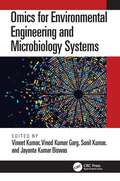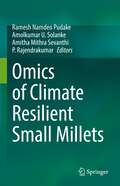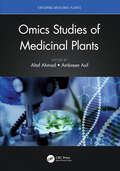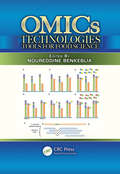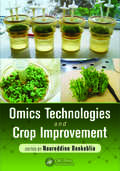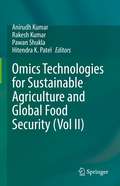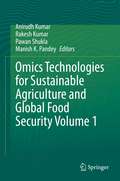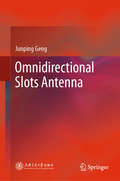- Table View
- List View
Oliver Bulleid's Locomotives: Their Design & Development (Locomotive Portfolio)
by Colin BoocockA history of the man who served as Chief Mechanical Engineer for the Southern Railway and the many locomotives he developed.Oliver Bulleid’s locomotives guides the reader in the quest to understand what motivated Mr Bulleid in his work as a senior engineer and manager, and tries, with as little bias as is reasonable, to make sense of some of the more controversial aspects of his activities. For example, why did OVB not pursue the ideal of a 2-8-2 for the Southern Railway? How did the ‘Leader’ project go so much out of control? What role did Bulleid play in the massive dieselization program in Ireland when he was CME there? How did the 0-6-6-0T turf-burning steam locomotive fit in with Ireland’s traction policy, or did it? And why did ninety of his steam locomotives and ninety-four of ‘his’ diesels have to be rebuilt to make them either more economical or more reliable?These are fundamental questions to which the book provides the reader with answers based on the author’s experiences or on those of people who knew Bulleid. OVB’s undoubted successes are illustrated in words and photographs, too, to provide a hopefully balanced picture of one of Britain’s more exciting railway engineers.“This book is a well written overview of the Bulleid era, by a competent engineer who can express himself in layman’s terms.” —Martin Shill, Industrial Railway Society“The book deserves a place on the bookshelf of every student of locomotives, especially Bulleid's By current standards, it is good value, and it was a pleasure to examine it.” —The Railway Observer
Oliver's Great Big Universe: the laugh-out-loud new illustrated series about school, space and everything in between!
by Jorge Cham&‘Mind-expanding and hilarious!&’ Jeff Kinney, author of the bestselling DIARY OF A WIMPY KID series. This hilarious new illustrated series will make you laugh-out-loud AND grow your brain. Perfect for readers age 8+ and fans of Diary of a Wimpy Kid and The 13-Storey Treehouse. Hi, I&’m Oliver! I know what you&’re thinking: what does an 11-year-old kid know about the universe? Am I a famous scientist? No. Am I a super-genius? Not really. I&’m just trying to figure out the usual stuff: new school, new friends, how to avoid my annoying sister. But there&’s one thing that DOES make sense: science! Outer space is totally my thing and I can tell you EVERYTHING you need to know about awesome stuff like: time-bending black holes how the Big Bang is like a fart aliens! (Well, there could be aliens.) From bestselling writer and robotics engineer Jorge Cham, Oliver&’s Great Big Universe is the first book in a STEM-themed, diary-style series. &‘An absolute gem!&’ Lincoln Peirce, author of the bestselling series BIG NATE. &‘A stellar confluence of comic episodes and cosmic information. In addition to brilliantly integrated comic moments – surprising plot twists add narrative pizzazz to a serious raft of data about the universe. An irresistibly entertaining introduction to astrophysics.&’ – Kirkus starred review &★
Olives and Olive Oil as Functional Foods: Bioactivity, Chemistry and Processing
by Apostolos Kiritsakis Fereidoon ShahidiThe only single-source reference on the science of olives and olive oil nutrition and health benefits Olives and Olive Oil as Functional Foods is the first comprehensive reference on the science of olives and olive oil. While the main focus of the book is on the fruit’s renowned health-sustaining properties, it also provides an in-depth coverage of a wide range of topics of vital concern to producers and researchers, including post-harvest handling, packaging, analysis, sensory evaluation, authentication, waste product utilization, global markets, and much more. People have been cultivating olives for more than six millennia, and olives and olive oil have been celebrated in songs and legends for their life-sustaining properties since antiquity. However, it is only within the last several decades that the unique health benefits of their consumption have become the focus of concerted scientific studies. It is now known that olives and olive oil contain an abundance of phenolic antioxidants, as well as the anti-cancer compounds such as squalene and terpenoids. This centerpiece of the Mediterranean diet has been linked to a greatly reduced risk of heart disease and lowered cancer risk. Bringing together contributions from some of the world’s foremost experts on the subject, this book: Addresses the importance of olives and olive oil for the agricultural economy and the relevance of its bioactive components to human health Explores the role that olive oil plays in reducing oxidative stress in cells-a well-known risk factor in human health Provides important information about new findings on olive oil and lipids which reviews the latest research Explores topics of interest to producers, processors, and researchers, including the fruit’s chemical composition, processing considerations, quality control, safety, traceability, and more Edited by two scientists world-renowned for their pioneering work on olive oil and human health, this book is an indispensable source of timely information and practical insights for agricultural and food scientists, nutritionists, dieticians, physicians, and all those with a professional interest in food, nutrition, and health.
Ollie and Harry's Marvelous Adventures
by Ollie Ferguson Harry FergusonOutdoor adventure and makerspace tech combine in this inspiring how-to from the brothers behind the popular Facebook page "The Days Are Just Packed." Ollie and Harry Ferguson have sailed a toy pirate ship across the Atlantic, engineered a giant catapult, and launched toy astronauts into space—and they haven’t stopped there. They’ve created a list of 500 adventures to help them live life to its fullest, from setting up a wildlife reserve to building an igloo. Ollie and Harry’s Marvelous Adventures features the best of the boys’ escapades, captured in vivid photographs and accompanied by step-by-step guidance on how to replicate them. The brothers’ days are just packed—and with the help of this inspiring guide, yours can be too.
Olympic Stadia: Theatres of Dreams
by Geraint John Dave ParkerOlympic Stadia provides a comprehensive account of the development of stadia including but not limited to: developments in running tracks, the introduction of lighting, improvements in spectator viewing standards and the introduction of roofs. Written by a world-renowned expert on sports architecture, the book: Systematically analyses every stadium from Athens 1896 to Tokyo 2020 Provides drawings, plans, elevations, photographs and illustrations in full colour Considers the fundamental changes wrought by the incorporation of the Paralympic Games Looks at the impact on host cities and their urban infrastructure, and considers the long-term legacies and massive investments that Olympic stadia require Explores the effects of the demands of the world’s TV broadcasters. An invaluable and beautiful resource for practical insight and inspiration, this book makes essential reading for anyone interested in Olympic stadia.
Omar Khayyam: On the Value of Time (Peacemakers)
by Nick M. LoghmaniThis book explores the life and work of Omar Khayyam as a provocateur of peace. While Khayyam is known for his poetry, he was foremost a prominent mathematician who looked at the world from a unique perspective. Using the transformative power of mathematics, he brought together seemingly irreconcilable concepts in his work. Through his art, philosophy, and mathematics, Khayyam sought to create harmony between what on the surface looks like a clash between his scientific view, romantic and often provocative poetry, and philosophy. The book sheds light on his spiritual and philosophical journey through a cross-sectional account of his poetry, philosophical view, and mathematics and science. It explores the complex inner life of a multidimensional scholar as he negotiated between faith and science, constructing a framework for peace by looking at the world as it presents itself to us, contemplating the temporality of life and enriching it with wisdom and joy. Historically and culturally informed, this book will be indispensable to readers of Omar Khayyam’s poetry and philosophy. It will also be of interest to students and researchers of peace and conflict studies, mathematics, science, Middle East literature, history, and popular culture.
Omega-3 Fatty Acids in Health and Disease
by Robert S. LeesA report from research in the MIT Sea Grant College Program. Discusses the relationship between particular fatty acids found only in fish oil, and human health. Presents and evaluates information on the health effects of dietary fats generally; evidence that fish oil consumption affects the incidenc
Omega-6/3 Fatty Acids
by Fabien De Meester Ronald Ross Watson Sherma ZibadiOver the last several years developing human research suggests that a component of omega-3 fatty acids, long chain ones, contribute particularly to health benefits. Omega-6/3 Fatty Acids: Functions, Sustainability Strategies and Perspectives focuses on developing information on this newly recognized key component. This volume uniquely, and for the first time, focuses on sustainability of natural sources of omega-3 fatty acids variants including long chain ones, and on ways to increase their use and availability to reduce major diseases. The authors review cardiovascular disease, neurological changes and mental health and other diseases like diabetes where long chain omega-3 fatty acids play protective roles from recent human trials. Each chapter evaluates developing information on the possible mechanistic role of long chain omega-3 fatty acids. After showing their requirement and involvement in health promotion there are reviews of various sources and ways to protect and promote them. Authors provide support for the benefits and sources of long chain omega-3 fatty acids and their increased dietary intake that reduce various physical and mental illnesses. Omega-6/3 Fatty Acids: Functions, Sustainability and Perspectives is a unique and important new volume that provides the latest data and reviews to physicians who need to assess serum omega-6/3 and fatty acids to help diagnose risks and change diets and to inform industry and the scientific community with reviews of research for actions including new studies and therapies.
OMICS: Biomedical Perspectives and Applications
by Debmalya Barh Kenneth Blum Margaret Anne MadiganA reflection of the explosion of research and development in this field, OMICS: Biomedical Perspectives and Applications explores applications of omics in bioinformatics, cancer research and therapy, diabetes research, plant science, molecular biology, and neurosciences. A select editorial panel of experts discusses their cutting edge omics researc
OMICS: Applications in Biomedical, Agricultural, and Environmental Sciences
by Debmalya Barh Vasudeo Zambare Vasco AzevedoWith the advent of new technologies and acquired knowledge, the number of fields in omics and their applications in diverse areas are rapidly increasing in the postgenomics era. Such emerging fields-including pharmacogenomics, toxicogenomics, regulomics, spliceomics, metagenomics, and environomics-present budding solutions to combat global challeng
Omics and Biotechnological Approaches for Product Profile-Driven Sorghum Improvement
by Ephrem Habyarimana Muhammad Azhar Nadeem Faheem Shehzad Baloch Nusret ZencirciThis edited book is focused on Sustainable Development Goal 2, which aims to achieve 'Zero Hunger.' It provides deep insights into the global sorghum status, limitations to its production, advancements in agronomic practices, and the application of high-throughput phenotyping technologies. Sorghum plays a vital role in global food security, agricultural sustainability, and rural livelihoods, making it an important crop for both developing and developed countries. It is a staple food for millions of people around the world, particularly in arid and semi-arid regions where other crops may struggle to grow. Sorghum exhibits significant genetic diversity, providing a rich resource for breeding programs aimed at developing improved varieties with traits such as higher yield, disease resistance, and nutritional quality. The book enhances readers' understanding of classical breeding methods and their role in sorghum improvement. It also focuses on the contribution of OMICs and biotechnological approaches to sorghum improvement. Detailed information about the genetic and genomic resources of sorghum provided is helpful for the scientific community to utilize in sorghum breeding. Chapters highlight sorghum genome sequencing, transgenic and hybrid sorghum, and the application of genome editing. This book is useful to the breeding community, serving as a resource for interdisciplinary research groups such as geneticists, breeders, biotechnologists, bioinformaticians, and students, supporting them in accelerating their activities related to sorghum breeding.
Omics and Genome Editing: Revolution in Crop Improvement for Sustainable Agriculture (Sustainable Landscape Planning and Natural Resources Management)
by Kartika SharmaThis book offers up-to-date research on genome editing and omics technologies from renowned academics with established backgrounds from throughout the globe. The world population is expected to touch 9–10 billion by 2050 and to feed the growing population, 50% more food must be produced globally than is currently produced. Nonetheless, it is a difficult challenge to increase the food output of the currently existing crops on available land. Over the past few decades, traditional crop enhancement techniques like plant breeding and other agricultural technology have made a significant contribution to food and nutritional security. With the use of strong technologies, genome editing strategies can significantly improve the productivity and efficiency of current agricultural practices. Discovering the underlying mechanisms influencing features of economic value has been made possible through genome editing through CRISPR/Cas9, primer and base editing, and OMICs through genomics, proteomics, metabolomics, transcriptomics, and phenomics. This book provides a wealth of information on omics and genome editing approaches and their application to develop abiotic, biotic, and climate-tolerant crops, as well as RNA interference, next-generation sequencing, and metabolomics for sustainable crop production. Researchers are actively using both genome editing and omics for crop improvement; however, there is limited literature offered in a single source. Undergraduate and postgraduate students, researchers, policymakers, and stakeholders will find this book to be an invaluable resource.
Omics and System Biology Approaches for Delivering Better Cereals (Genome Designing of Crops)
by Dinesh Kumar Saini Chittaranjan KoleThe book explores the available omics resources, the integration of multi-omics data, and systems biology methods, focusing on their applications in cereals breeding and research. It highlights current and innovative strategies to understand complex traits, to improve yield, and to enhance resistance to biotic and abiotic stresses. It also addresses the challenges and opportunities associated with modeling multi-omics data and analyzing systems-level information. By leveraging systems biology and integrated omics research, this book aims to redefine the future research agenda for cereal improvement.
OMICS Applications in Crop Science
by Debmalya BarhMerging topical data from recently published review and research articles, as well as the knowledge and insight of industry experts, Omics Applications in Crop Science delves into plant science, and various technologies that use omics in agriculture. This book concentrates on crop breeding and environmental applications, and examines the applicatio
Omics Approaches for Sugarcane Crop Improvement
by Rajarshi Kumar GaurIn this book, the information encompasses various researchable biotechnology aspects of sugarcane, its genomic structure, diversity, comparative and structural genomics, data mining, etc. This book explores both the theoretical and practical aspects of sugarcane crops, focusing on innovative processes. This book argues in favor of developing an integrated research and development system to strengthen the research and development capabilities of all the areas of sugarcane. Further, it covers the recent trends of sugarcane biotechnology, especially in the next-generation sequencing (NGS) era. This book will be very useful for professors and scientists who are working in the area of sugarcane crops by using molecular biology and bioinformatics. It is also useful for students to use as a reference for their classes or thesis projects. Key features: • Discusses an integral part of molecular biology and pivotal tools for molecular breeding; enables breeders to design cost-effective and efficient breeding strategies for sugarcane • Discusses the harnessing genomics technologies for genetic engineering and pathogen characterization and diagnosis of sugarcane • Provides new examples and problems, added where needed • Provides insight from contributors drawn from around the globe
OMICS-Based Approaches in Plant Biotechnology
by Rintu Banerjee Garlapati Vijay Kumar S.P. Jeevan KumarBurgeoning world population, decreased water supply and land resources, coupled with climate change, result in severe stress conditions and a great threat to the global food supply. To meet these challenges, exploring Omics Technologies could lead to improved yields of cereals, tubers and grasses that may ensure food security. Improvement of yields through crop improvement and biotechnological means are the need-of-the-hour, and the current book “OMICS-Based Approaches in Plant Biotechnology”, reviews the advanced concepts on breeding strategies, OMICS technologies (genomics, transcriptomics and metabolomics) and bioinformatics that help to glean the potential candidate genes/molecules to address unsolved problems related to plant and agricultural crops. The first six chapters of the book are focused on genomics and cover sequencing, functional genomics with examples on insecticide resistant genes, mutation breeding and miRNA technologies. Recent advances in metabolomics studies are elucidated in the next 3 chapters followed by 5 chapters on bioinformatics and advanced techniques in plant biotechnology and crop breeding. The information contained in the volume will help plant breeders, plant biotechnologists, plant biochemists, agriculture scientists and researchers in using this applied research to focus on better crop breeding and stress adaptation strategies.
OMICs-based Techniques for Global Food Security
by Sajid FiazOMICs-based Techniques for Global Food Security Forward-thinking resource discussing how to integrate OMICs and novel genome editing technologies for sustainable crop production OMICS-based Techniques for Global Food Security provides an in-depth understanding of the mechanisms of OMICs techniques for crop improvement, details how OMICs techniques can contribute to identifying genes and traits with economic benefits, and explains how to develop crop plants with improved yield, quality, and resistance to stresses through genome editing technologies, providing evidence on the developments of climate resilient crops via applications of genome editing techniques throughout. The text covers the application of OMICs in crop plants, the integration of bioinformatics and multi-OMICs for precision breeding, de-novo domestication, CRISPR/Cas system for crop improvement, hybrid seed production, transgene free breeding, regulation for genome edit crops, bioinformatics and genome editing, and other topics related to OMICs and genome editing. The text also includes a chapter on global regulations for genome edited crops, and explains how these regulations influence novel plant breeding techniques in their adopted countries. Edited by two highly qualified academics, OMICs-based Techniques for Global Food Security covers topics such as: Crops genome sequencing and their application for crop improvement, and functional characterization of cereal genome The role of OMICs-based technologies in plant sciences and utilization of different multi-OMICs approaches for crop improvement Genomic database and genetic resource of cereals, speed breeding for rapid crop improvement, and evolution of genome editing technologies CRISPR system discovery, history, and future perspective, and CRISPR/Cas system for biotic and abiotic stress resistance in cereals Providing a collection of recent literature focusing on developments and applications of OMICs-based technologies for crop improvement, OMICs-based Techniques for Global Food Security is an important read for plant breeders, molecular biologists, researchers, postdoctoral fellows, and students in disciplines for developing crops with high yield and nutritional potential.
Omics for Environmental Engineering and Microbiology Systems
by Vineet KumarBioremediation using microbes is a sustainable technology for biodegradation of target compounds, and an omics approach gives more clarity on these microbial communities. This book provides insights into the complex behavior of microbial communities and identifies enzymes/metabolites and their degradation pathways. It describes the application of microbes and their derivatives for the bioremediation of potentially toxic and novel compounds. It highlights the existing technologies along with industrial practices and real-life case studies. Features: Includes recent research and development in the areas of omics and microbial bioremediation. Covers the broad environmental pollution control approaches such as metagenomics, metabolomics, fluxomics, bioremediation, and biodegradation of industrial wastes. Reviews metagenomics and waste management, and recycling for environmental cleanup. Describes the metagenomic methodologies and best practices, from sample collection to data analysis for taxonomies. Explores various microbial degradation pathways and detoxification mechanisms for organic and inorganic contaminants of wastewater with their gene expression. This book is aimed at graduate students and researchers in environmental engineering, soil remediation, hazardous waste management, environmental modeling, and wastewater treatment.
Omics of Climate Resilient Small Millets
by Ramesh Namdeo Pudake Amolkumar U. Solanke Amitha Mithra Sevanthi P. RajendrakumarThis edited book covers all aspects of omics approaches used for the varietal improvement of millets in changing climatic conditions. Millets are the collection of small-grained cereal grasses, that are grown for human carbohydrate needs. They are among the oldest crops, mainly divided into two groups – Major and small millets based on seed size. Small millets are earlier considered orphan crops, but recently due to their nutritional values, they are getting importance in cultivation. This book explores the genomics, transcriptomics, proteomics, metabolomics, bioinformatics, and other omics tools that are being widely used to get a clear understanding of mechanistic approaches taken by plant genes to tolerate stress. Various reports are published based on field breeding on these crops, and recently the genome of some of the small millets is released, and many omics studies are published related to its application in varietal improvements. This book reviewed all those recent studies and is of interest to research students, plant breeding scientists, teachers that are working in agriculture and plant biotech universities. Along with this, the book serves as reference material for undergraduate and graduate students of agriculture, and biotechnology. National and international agricultural scientists, policymakers will also find this to be a useful read.
Omics Studies of Medicinal Plants (Exploring Medicinal Plants)
by Altaf Ahmad Ambreen AsifHerbal drugs play a pivotal role in modern medicine and pharmaceutical care; however, only limited biotechnology applications have been seen in medicinal plants. Revolutions in high-throughput approaches emphasize omics approaches, such as genomics, transcriptomics, proteomics, and metabolomics. A volume in the Exploring Medicinal Plants series, this book provides a comprehensive and in-depth analysis of breakthroughs in high-throughput approaches for the research of medicinal plants. Exploring the principles and applications of omics technologies, this book is essential for those working on or are involved in the modern research of medicinal and aromatic plants. There is also a strong focus on practical implications of these technologies through exploring the safety aspects and conservation strategies of various plants. From informative discussions on the latest research to a holistic evaluation of their potential applications, this book appeals to students, researchers and professionals working with medicinal and aromatic plants, as well as healthcare professionals interested in the area.
OMICs Technologies: Tools for Food Science
by Noureddine BenkebliaSince the completion of the Human Genome Project, food and nutrition sciences have undergone a fundamental molecular transformation. New discoveries in molecular biology, analytical chemistry, and biochemistry have led to the development of new tools that are likely to revolutionize the study of food. OMICS Technologies: Tools for Food Science expl
Omics Technologies and Crop Improvement
by Noureddine BenkebliaIncreased world population, decreased water supply, and climate change all put stresses on the global food supply. An exploration of the challenges and possible solutions to improve yields of the main crops, such as cereals, roots, tubers, and grasses, Omics Technologies and Crop Improvement reviews data on food sciences and omics. The book covers
Omics Technologies for Sustainable Agriculture and Global Food Security (Vol II)
by Anirudh Kumar Rakesh Kumar Pawan Shukla Hitendra K. PatelThis edited book brings out a comprehensive collection of information on the modern omics-based research. The main focus of this book is to educate researchers about utility of omics-based technologies in rapid crop improvement. In last two decades, omics technologies have been utilized significantly in the area of plant sciences and has shown promising results. Omics technology has potential to address the challenge of food security in the near future. The comprehensive use of omics technology occurred in last two decades and helped greatly in the understanding of complex biological problems, improve crop productivity and ensure sustainable use of ecosystem services. This book is of interest to researchers and students of life sciences, biotechnology, plant biotechnology, agriculture, forestry, and environmental sciences. It is also a useful knowledge resource for national and international agricultural scientists.
Omics Technologies for Sustainable Agriculture and Global Food Security Volume 1
by Anirudh Kumar Rakesh Kumar Pawan Shukla Manish K. PandeyIncreasing world population, unpredictable climate and various kind of biotic and abiotic stresses necessitate the sustainable increase in crop production through developing improved cultivars possessing enhanced genetic resilience against all odds. An exploration of these challenges and near possible solution to improve yield is addressed in this book. It comprehensively and coherently reviews the application of various aspect of rapidly growing omics technology including genomics, proteomics, transcriptomics and metabolomics for crop development. It provides detailed examination of how omics can help crop science and introduces the benefits of using these technologies to enhance crop production, resistance and other values. It also provides platform to ponder upon the integrative approach of omics to deal with complex biological problems. The book highlights crop improvement such as yield enhancement, biotic and abiotic resistance, genetic modification, bioremediation, food security etc. It explores how the different omics technology independently and collectively would be used to improve the quantitative and qualitative traits of crop plants. The book is useful for graduate and post-graduate students of life science including researchers who are keen to know about the application of omics technologies in the different area of plant science. This book is also an asset to the modern plant breeders, and agriculture biotechnologist.
Omnidirectional Slots Antenna
by Junping GengOmnidirectional antenna with high gain, low profile, vertical polarization, even CP polarization is very difficult to design, although it is from the dipole. In this book, a novel idea that the running wave in the coaxial wire is disturbed by the orthogonal slot array on the cylindrical metal shell is introduced, which radiates the CP wave in omni-direction. When feeding on two ends of the coaxial wire respectively, there will appear left hand circularly polarized (LHCP) omnidirectional radiation or right hand circularly polarized (RHCP) omnidirectional radiation. By introducing the T-shaped feed structure, the coaxial wire with slot array can conveniently produce the LHCP and RHCP radiation diversity with one end feeding. In the further, combining with the directional antenna, it will generate the pattern diversity in the half-sphere space. The antenna of the coaxial wire with slot array can further transform into conical CP beam antenna if the coaxial wire becomes into a conical frustum. By introducing the PIN diode into the slot, the antenna of the coaxial wire with slot array can radiate the reconfigurable directional beam by switching the states of the PIN diodes. By introducing a novel switchable microwave circuit, the omnidirectional /directional pattern switchable antenna can be realized easily.This book proposes a continues method to develop the potentialities of the omnidirectional antenna. And the readers can study the method or ideas of the omnidirectional slots antenna, even graft the CP or diversity methods to other antennae.
